Performance
The Samsung SC-DC173 is equipped with a single 1/6-inch CCD, with a gross pixel count of 680,000. The effective pixel count is not given, though we can estimate it to be somewhere around 340,000. This is the standard chip size found in most low-end camcorders. The 1/6-inch CCDs are cheap and produce less than stellar results, although a good manufacturer can make them perform to their utmost capabilities. Let’s see how Samsung did.
Casual shooting with the Samsung SC-DC173 yielded lackluster video. The images appeared noisy, as a rule, and the color balance was often slightly askew. The auto focus did well, but the dynamic range was limited. White objects in a shot with mixed tonality frequently blew out. Dark areas in the same shot often bottomed out, lost in shadow. The picture was not terrible, though. It performed like a modest camcorder in its price range– no more and no less.
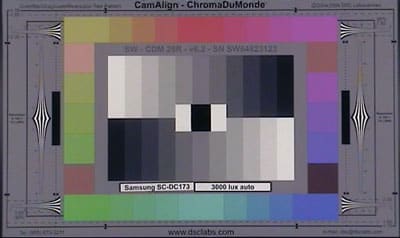
Our standardized testing takes place in the lab, shooting a DSC Labs ChromaDuMonde chart at an even 3000 lux. Under these more or less ideal conditions, the camcorder produced a grainy image with flat, though not entirely poor, color. The biggest problem with the image is the artifacting. You can see blocks of compression quite clearly. It’s most apparent in areas of high contrast, even on a small monitor. In other areas, it appears more as imager noise and random bits of discoloration. Altogether, the image looks fuzzy.
The color performance was not too bad, however. It certainly won’t win any awards, but the colors manage to remain distinguishable without oversaturation, which is commonly employed as a cheap fix for low-end camcorders.
Though the imager was larger in last year’s SC-DC164, the results were about the same. The DC164 did not take the manual white balance as well and produced too warm an image, but the noise and artifacts were a problem then, too. When comparing camcorders, the Sony DCR-DVD108 is a perfect example of a camcorder with oversaturated colors. Some of your image may look better, but often a particular color, like red or blue, will appear almost neon. Sharpness was about the same between the Sony and Samsung. The Canon DC220 also oversaturated, but it only appeared to be a problem with greens. Noise was also a problem, as it was with all these camcorders.
The differences in color are difficult to parse. While we place a higher value on accuracy, consumers with low-end camcorders often prefer images that "pop." We recommend you check out a few models at the store first. Look for stronger colors from Sony and Canon, and a toned-down performance from Samsung. Your preference is your own, but we would be most pleased with something between the Canon and Samsung. Of course, the Canon DC220 gives you options to tweak saturation right onboard, something the Samsung sorely lacks.
Video Resolution* (4.5)*
Video resolution is determined by shooting a DSC Labs video resolution chart and viewing the recorded footage on a monitor. This test measures the resolution of the final outputted video after it has been chewed up and spit out of the processor. At best, the Samsung SC-DC173 produced a horizontal resolution of 300 line widths per picture height (lw/ph) and a vertical resolution of 300 lw/ph.
The score is on par with camcorders in its price range.
Low Light Performance* (2.46)*
The small 1/6-inch CCD does not offer much hope for low light, but each camcorder gets its fighting chance. Our lab test is a comprehensive little battery of challenges. The first is shooting the DSC Labs Chroma DuMonde chart at 60 lux. At this light level, which is dim but adequate for reading, the noise levels skyrocketed. It became quite apparent that this is not a power player in low light. Some of the colors held on strong, but color differentiation became a problem. Mostly due to the noise, fine detail took a nosedive. We also saw a fair amount of bluish noise, which is often the case with low-end Sonys. It is likely an imager aberration. Because 60 lux shooting is not far off from indoor lighting, this is the video you can expect from indoor shots.
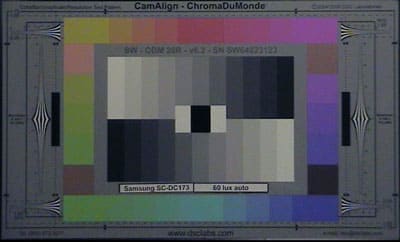
The Samsung SC-DC173 offers shutter speed control, but it does not drop below 1/60 of a second (at least not in 16:9, which is how we test) and is therefore useless in low light. You can, however, use the exposure controls. We shot the same 60 lux with the exposure extended to a maximum +29. At this setting, the exposure increased significantly, with no tangible increase in motion blur. Fine detail capture improved slightly because it was able to draw the contrast out a little better, but the noise was not diminished one bit.
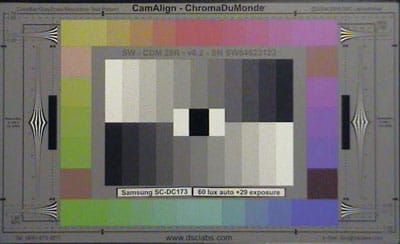
Last year’s Samsung SC-DC164 produced similar results. The DC164 had a warmer image and possibly better fine detail resolution. The Sony DCR-DVD108 produced an image with seriously oversaturated blues, to the detriment of surrounding colors. Blue noise was also prevalent. Finally, the Canon DC220 produced the brightest colors in an even fashion. The noise was also the lowest amongst this group. However, making out fine details is nearly impossible.
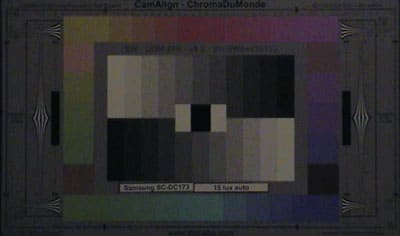
Lowering the light to 15 lux, the Samsung SC-DC173 was all noise and darkness. All fine detail was gone. Colors could still be ascertained, so Samsung gets something right, but the chip is simply too weak to perform in this light.
The next part of our test shoots the GretagMacBeth Color Checker chart at 60 lux, then exports frames from the video into Imatest imaging software to gauge color accuracy, noise, and saturation. At best, the Samsung SC-DC173 is able to produce a color error of 12.8, which is really not too bad when compared to the broad spectrum of performances we’ve seen this year. The noise measured 2.53 percent. Unlike the color score, the noise is much, much higher than a lot of camcorders. This did not come as a surprise after seeing the video with our own eyes. The saturation measured 70.43 percent.
The final part of the test determines the sensitivity of the camcorder. We monitor the IRE levels and lower the light until the camcorder is capable of producing a maximum brightness of 50 IRE. In the case of the Samsung SC-DC173, the light could only go as low as 19 lux. We typically see a better performance from single-chip camcorders. Even other 1/6-inch CCD camcorders like those from Sony could go down to 15 lux.
Stabilization* (7.68)*
We tested the effectiveness of the SC-DC173’s DIS using our custom-built shake emulator. The camcorder was set to auto with the LCD screen flipped out and mounted to the shake emulator. We tested the SC-DC173 at two speeds. Speed one is akin to walking slowly down the sidewalk while filming. Speed two simulates a more intense shake pattern, similar to a light jog or bumpy car ride. At speed one, the SC-DC173 produced a shallow 33.3 percent shake reduction and a disappointing zero percent reduction at speed two. This is not an adequate performance for most standards.
Wide Angle* (11.2)*
We tested the SC-DC173’s maximum field of view by placing the camcorder on a tripod, pulling the zoom all the way back and disabling DIS. A vertical laser was used to measure both left and right angles. After viewing the test footage on a true full frame monitor, we were able to calculate the SC-DC173’s wide angle measurement by subtracting the difference of the left and right angles. The SC-DC173’s maximum field of view is 56 degrees in 16:9 mode and 45 degrees in 4:3 mode—an optimal performance.
Format
Compression* (4.0)*
The Samsung SC-DC173 records video in the MPEG2 format, shared amongst nearly all standard definition DVD and hard disk drive (HDD) camcorders. MPEG2 compression creates more artifacting than the tape-based DV compression, resulting in a generally poorer quality most of the time. However, people often prefer it because DVD is a more convenient media.
There are three quality settings on the SC-DC173: the highest quality, XP, then SP, and finally LP. Because the performance of this camcorder is not great, we recommend that you not cripple it any further by shooting in a lower quality.
Media* (5.0)*
The Samsung SC-DC173 records video to 8cm DVD discs, sometimes called miniDVDs, in the DVD-R, DVD-RW, DVD+RW, and DVD+R DL (dual layer) formats. DVDs are very convenient for simply playback. Once the discs undergo the finalization process in the camcorder, they can be popped into most home DVD players. But don’t count on DVDs to hang around on the shelves forever. DVDs that have been burned in your home aren’t made of the same materials as a movie you purchase and may have a shorter shelf life. The best practice is to back your footage up on a hard drive, as well. Of course, there could be problems there. Read on in the next section.
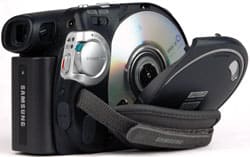
Editing* (5.0)*
The video files produced by the Samsung SC-DC173 records to DVD in a file structure that can be tricky to import into an editing program. The problem is that individual clips are not saved as unified, single files on the DVD. They conform to a directory structure, and you need some software or codec to interpret that structure in order to play it back. The SC-DC173 ships with a codec for playing it back, but unlike most camcorders, there is no editing software in the box. So you not only need to purchase your own editing program, but you have to hope that it can work with Samsung’s files. Most modern editing software shouldn’t have a problem. There are often special importing tools to grab footage from a DVD. But overall, we can’t describe this as a painless process.
Auto / Manual Controls
Picture & Manual Control
Automatic Control (4.25)
The Samsung SC-DC173 features an "Easy Q" mode, activated by a button on the left side. Similar to the Sony Easy button, and even more restrictive, Easy Q mode allows you absolutely no access to any menu or control. This seems like a great idea to satisfy technophobic point-and-shooters, but the auto controls do not perform well enough to give that audience the support they need. Some controls are quite adequate, while others demand manual intervention.
Perhaps the most important auto control is focus, and in this area the Samsung SC-DC173 does fine. Even at extended zooms, the auto focus remains pretty tight (which is fortunate, because the manual focus controls are terrible). The white balance is decent, taking only a few seconds to make shifts from one temperature to another. Mixed lighting, such as shooting near a window indoors, is a problem. We found the camcorder veering too often toward warm tones. The auto exposure is not great. Part of the issue appears to be that the camcorder does not have a great dynamic range. Shots with a complex mix of bright areas, mid-tones, and shadows will see too much information lost in the shadows and hotspots. When you try to shift exposure by putting the shadow or hotspot area in the center of the shot, or if you try to zoom in so it fills up more of the screen, the camcorder takes a very long time to adjust. Simply put, it’s not up to par.
The Samsung SC-DC173 includes Program AE modes (often called "Scene modes"), which allow for one-touch correction during specific, tricky lighting situations. The camcorder can’t be in Easy Q mode to use them. Program AE modes include: Sports, Portrait, Spotlight, Sand/Snow, and High Speed. The camcorder also offers backlight compensation as a one-touch control. When a subject is too strongly backlit, making them a silhouette, this feature boosts the overall exposure in order to bring out detail in the subject.
Overall Manual Control (4.0)
The manual control suite for the Samsung SC-DC173 is decent, hampered by the frustrating and poorly-designed joystick. Located on the left side, along with pretty much every other button, it’s almost as if Samsung has done everything possible to keep the controls hidden from you while shooting. This design would be fine if you did most of your shooting from a tripod or fixed surface, but that’s not the case with most point-and-shooters. As it is, you’ll either have to tilt the camcorder toward you or crane your neck around to see the buttons on the left side.
The manual controls are lacking in their own right. Take shutter speed, for instance, which might look fine in Auto mode in a moderately low light level. But when you switch it to Manual mode, the picture suddenly darkens. It wouldn’t be a problem if the manual setting allowed you to go below 1/60of a second, but it doesn’t. What good is a manual setting if it doesn’t allow you to recreate what the camcorder can do in Auto mode? The focus controls are no joy either, but that’s fairly standard for a consumer camcorder.
The other controls based in the menu, including exposure compensation and white balance, are not as bad, but their usage is still crippled by the poorly-placed joystick.
Zoom (4.0)
The zoom is controlled by a thin piece of plastic located on top of the body. Though well-placed for the index finger, it feels cheap, offering little counter-pressure to help control fine adjustments. A 34x optical zoom is no mean offering, but it makes proper control all the more important. Unfortunately, the SC-DC173 comes up short. When the zoom toggle is touched, a small progress bar appears at the top of the screen to give you a rough idea of where in the zoom range you are. Rough is the operative word here, as a 34x zoom is big, and the graphic is small. There is no numerical indication of the exact zoom value, which makes tight control problematic. Digital zoom is engaged in the Camera submenu of the main menu. It does not function when the camcorder is recording in 16:9.
*
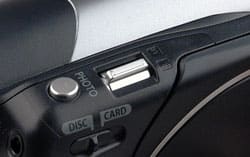
Zoom Power Ratio (34.0)*
The optical zoom on the Samsung SC-DC173 extends to a powerful 34x. Many first-time shoppers make the mistake of equating powerful zooms with good quality camcorders. This is, in fact, often the reverse. Because of optical requirements in regards to lens barrel length, consumer camcorders with larger and better imagers are generally limited to zooms of 10x to12x. Smaller imagers allow for larger zooms, which manufacturers push higher and higher in a numbers war that benefits few. Most shots past 5x to6x taken by hand start to shake. At 34x, forget it.
The digital zoom extends to 1200x, but can be capped at several lower levels: 100x, 200x, and 400. No other camcorder seems to offer this much control over digital zoom, and probably for good reason. The whole problem with digital zoom is that the quality deteriorates so quickly, few people actually care how bad it gets after 100x or more.
Focus (4.0)
The manual focus on the Samsung SC-DC173 is poor. It comes as no great surprise on a mid-level camcorder, but it stings the heart no less. This is only control that gets its own external button, located at the bottom of the LCD cavity. We’ll hand it to Samsung – while most manufacturers employ the somewhat arcane icons of a mountain and a person when manual control is activated, Samsung spells it out: one side of the screen says "Near," and the other side says "Far." Use the joystick to shift focus. While the simplicity is great, the low resolution and small size of the LCD and viewfinder are all but useless for making tight focus decisions. You’ll really only know after shooting, when you see the footage on a larger screen, if the shot was truly in focus. In all but extreme cases, it will be best to let auto focus do its job.
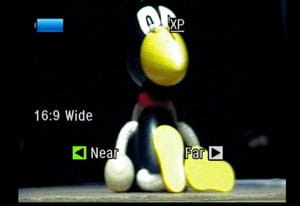
The focus control
Exposure & Aperture (5.5)
The Samsung SC-DC173 features a relatively easy to use exposure compensation tool. Called "Exposure," the control is located in both the Q menu and the Full menu. When activated, a small scale appears in the lower-left side of the screen. Use the joystick to move the small cursor back and forth across the range, which runs from 00 to 29 in whole number increments. The numbers themselves are totally arbitrary – they have no discernable relation to shutter speed or aperture. On the whole, the control works well. It moves too slowly for power users, but beginners will appreciate the simplicity.
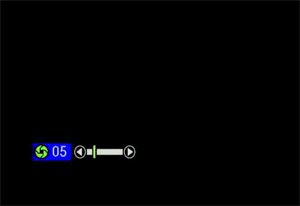
The Exposure control in action
Shutter Speed (5.7)
The shutter speed on the Samsung SC-DC173 operates much the same as exposure, but lacks the effectiveness. When activated, the same small scale appears in the lower left part of the screen. Shutter options include 1/60, 1/100, 1/250, 1/500, 1/1000, 1/2000, 1/4000, and 1/10000. The fact that the slowest possible shutter speed (under most conditions) is only 1/60 presents a problem. As we mentioned a few paragraphs above, there is a big discrepancy between what the camcorder can produce in Auto mode and what the manual controls allow. When in Auto mode, the camcorder does a decent job of exposing for moderately low light, but when the manual control is engaged and the display reads 1/60, the shot is suddenly very dark. This means either the Auto mode allows the shutter to drop below 1/60 (which does not seem likely, as there is no discernable motion blur), or engaging manual shutter speed is turning off some kind of auto gain. Whatever the reason, this makes the manual shutter all but useless in low light, which is precisely when you want it handy.
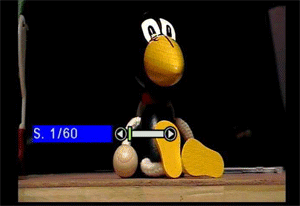
The shutter control in action
The camcorder does offer the option of 1/30 and 1/15 shutter speed, activated by an external button in the LCD cavity. Push it once to shift to 1/30, a second time to activate 1/15, and a third time for 1/15 with the LED light on. However, the camcorder must be in 4:3 mode, not 16:9, and the image stabilization must be off. With these restrictions, it hardly qualifies as a useful or dependable control. If the room is dark and you need to shoot by hand, forget about it – your shot is lost.
White Balance (5.0)
The Samsung SC-DC173 white balance options are located in the Q menu and the full menu. The choices are pretty limited: auto, indoor, outdoor, and Custom (manual) WB. In order to set the manual white balance, point it at your reference white or grey then select the Custom setting. Push in on the joystick once and you’re all set. The shift is in credibly fast, so fast you may feel like the setting was inaccurate. From our experience, though, it was not. This is just a fast control. Not everyone has time for manual settings, though. In those cases, a powerful collection of presets can come in handy, like multiple outdoor and indoor color temperature settings. Samsung does not deliver on this, however.
Gain (0.0)
The Samsung SC-DC173 does not offer gain control.
Other Manual Controls (0.0)
None.
Still Features
Still Features* (4.25)*
When the disc/card switch is shifted to card, the SC-DC173 is capable of capturing still images to an SD or MMC card in one resolution—800 x 600. You can choose between super fine, fine, and normal quality settings, but even at super fine, the SC-DC173 will give you a poor one-half megapixel image. The Administrative menu offers control over white balance, exposure, and backlight compensation. The only other still feature offered by the SC-DC173 is the photo capture shutter sound. There is no burst mode, no bracketing mode. That’s it—quite sad. One semi-cool trick is the ability to capture stills directly from video playback and save them the card.
Still Performance* (3.54)*
The still performance of the Samsung SC-DC173 was tested by shooting the GretagMacBeth Color Checker chart and running the stills through Imatest imaging software to determine color error, noise, and saturation. At best, the camcorder was able to produce a color error of 11.9, with a noise level of 1.2225 percent and a saturation of 74.87 percent. The error score fares relatively well compared to other camcorders, but the color accuracy is only one part of the story.
Actually looking at the pictures is not a pleasant experience. The photos are low quality, fuzzy, and lack fine detail. Motion blur seems to be a constant risk. The 800 x 600 resolution ranks right alongside those toy cameras that attach to your key ring.
Still Resolution* (3.16)*
We test still resolution by shooting an Applied Image ISO 12233 resolution chart and running those stills through Imatest imaging software. At best, the Samsung SC-DC173 produced a horizontal resolution of 486.8 line widths per picture height (lw/ph) with 1.85 percent clipping and 16.8 percent oversharpening. It produced a vertical resolution of 403.1 lw/ph with 0.56 percent clipping and 26.5 percent oversharpening.
As mentioned above, the pictures do not look very good to the eye. Though the scores are not bad, considering the limited size of the images, they appear fuzzy.
Handling and Use
Ease of Use* (6.5)*
When it comes to ease of use, the SC-DC173 is all about one thing: Easy Q. Easy Q is Samsung’s version of Sony’s Easy mode. When Easy Q is enabled, the camcorder slips into full autopilot, including the activation of digital image stabilization. If you dare to press the menu, C.Night/video light, or manual focus button, a jarring blue screen will fill the LCD or viewfinder, exclaiming "Release the Easy Q!" as if you are corrupting an royal decree with your negligence. Yikes. Sorry, Samsung. While in Easy Q, you can still access the fader, display button, and LCD enhancer, in addition to zooming and recording. Point-and-shooters, this will be your saving grace—just go easy on the button pressing while in Easy Q, or else the SC-DC173 might explode into a thousand pieces out of anger. In all seriousness, shooting in Easy Q is very restrictive. Only the absolute minimum point-and-shoot crowd will find this a please. Even Sony’s Easy mode gives you some access to controls.
Life outside Easy Q is not quite as simple, yet more sophisticated—at least for this camcorder’s standards. Samsung has done well with the button placement of the SC-DC173. All the LCD cavity buttons are arranged in a vertical strip closest to the rear end of the camcorder for easy access. In addition, there is a Q.Menu button that offers quick control over features like program AE modes, white balance, shutter speed, and exposure. DIS and BLC are also available in this menu (which is essentially akin to a Function menu). To top it all off, the LCD panel contains a column of controls, including LCD enhancer (which brightens the LCD screen), Zoom In/Out, and Record Start/Stop. This is a nice layout, Samsung.
We do have a couple gripes, though. The side-mounted joystick is great to have, but it means your fingers will get in the way of the LCD every time you go to adjust with it. The rear end or LCD panel would have been more optimal locations for the joystick, but it will just take a bit of a learning curve to master its annoyance. Also, you can’t use the Night modes, video light, and digital zoom during 16:9 recording—they’re only available in 4:3. This is a royal pain, as most shooters will want to take advantage of the wide-screen option to meet the near-standard of today’s viewing experience. Lastly, the SD/MMC card slot is located on the bottom of the camcorder, meaning you have to remove the SC-DC173 from a tripod in order to swap out a card. Since the SC-DC173 can only record still images to a memory card, you’ll find it to be quite taxing during a long photo shoot with a 32MB card.
Handling* (4.0)*
While the SC-DC173’s video quality is passable, the camcorder is lacking in the handling department. However, the architectural revamping implemented since last year’s SC-DC164 is a bit of a mixed bag. Both camcorders are nearly identical when it comes to the front and right sides. Samsung’s most prominent mistakes with the SC-DC173 include ditching the mic jack and extendable viewfinder. The unfavorable side-mounted joystick has been carried over, though, and it has received a blocky, whittled design that only equates to less functional maneuverability. It also hurts your fingers after a few minutes of toggling through the menu. In addition, where did all the ports go? It appears as though Samsung designed the jack and terminal placement on the SC-DC173 via the Pin the Tail on the Donkey method—they’re all over the place. Last year, the SC-DC164 boasted a strip of ports within the LCD cavity, easy to find and out of harm’s way.
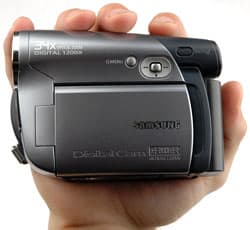
On the bright side, Samsung has done some necessary housekeeping with its buttons. The DC-SC164 was devoid of LCD panel controls and littered with randomly placed buttons within its LCD cavity. This year, the SC-DC173 proudly sports LCD panel controls and features a total of four buttons placed toward the rear end of the LCD cavity. Still, it’s annoying to use the side-mounted joystick because your fingers block the view of the LCD screen. The back of the camcorder or the LCD panel are two prime locations for a joystick—Samsung, see Panasonic, Canon, and JVC for good examples.
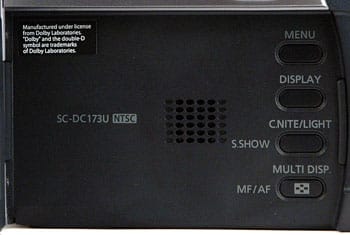
*A close-up of the LCD cavity and its buttons. *
Now let’s talk comfort factor. The SC-DC173 may not be a top of the line performer, but it feels good around the hand. The hand strap is high strung, wide, and padded with plush foam. The SC-DC173 will not flop to the side like most camcorders—it remains rigid and glued to the palm of the hand. As with most camcorders, those with large hands will overshoot the zoom toggle and photo button with the index finger. The pinky also has a tendency to wander into the lens’s field of view. A way to amend this is to shift your hand down a bit within the strap so your finger rest atop the necessary controls. The SC-DC173 has its eclectic design flaws, but will comply with a long day of shooting.
Menu* (5.0)*
Samsung offers one of the better menu designs in the industry. It’s straightforward, organized, and convenient. Its downfall is that all action is controlled by the side-mounted joystick, which will leave you craning your neck and blocking the LCD screen with your fingers. Once you figure out a decent strategy, shifting through the menu becomes a breeze.
One caveat we have regarding the SC-DC173’s menu operation is that every time you shift to a new option, a brief electrostatic pulse sound can be heard. This applies to pressing the menu buttons as well. If you plan on making adjustments while shooting, just be aware that your recorded audio will be peppered with faintly audible robot-talk.
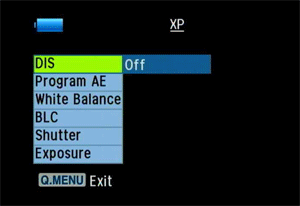
Q.Menu in action
There are two menus—the Administrative menu and the Q.Menu. When the Easy Q mode is activated, no menu is available. The Q.Menu is the equivalent to a "Function menu" found on other manufacturers’ camcorders. These contain the controls most pertinent to shooting: exposure, white balance, etc. To access the Q.Menu, simply press the Q.Menu button, and a small list of options will appear in the bottom left corner of the LCD screen. The list is composed of DIS, Program AE, White Balance, BLC (backlight compensation), Shutter Speed, and Exposure settings. In order to select any of the aforementioned options, shift the joystick to the right, scroll up or down to set the parameters of the option, and press the center of the joystick to select that particular setting. The same process applies to the Administrative menu as well.
To access the Administrative menu, press the menu button in the LCD cavity. A list of the following submenus will appear on the left side of the screen: Camera, Record, Disc Manager, Display, and System. Camera is composed of Program AE, white balance, digital effect, shutter speed, exposure, 16:9, DIS, BLC, and digital zoom settings. Record offers Record mode and wind cut settings. Disc manager allows you to finalize, un-finalize, format, or check disc info. Display provides options for LCD bright, LCD color, date/time, and TV display settings. Finally, system consists of clock set, beep sound, language, and demonstration settings.
Portability* (5.0)*
The SC-DC173 is reasonably portable—it’s no pint-sized JVC Everio, but it won’t engulf the entirety of your camcorder bag. The SC-DC173 measures 87 x 121 x 54mm (3.43 x 4.76 x 2.13-inches) and weighs 360 grams (0.79 pounds/12.70 ounces) without the battery pack. Those are pretty standard dimensions for an entry-level DVD camcorder. A small camera bag will do—just make sure there’s room for extra discs and supplies. Since the SC-DC173 is comfortable to hold, you should have no problem shooting all day. You’ll just need to invest in a bigger battery to endure the many hours it takes to trace the Freedom Trail (yes, that’s a Boston shout out).
LCD and Viewfinder* (4.0)*
The SC-DC173 is equipped with a 2.7-inch wide LCD screen that flips out 90 degrees from the camcorder’s body and rotates a full 270 degrees. The LCD screen has a 112,000-pixel resolution and solarizes when tilted at the slightest angle. Anti-solarizing technology has been around for years. It’s time Samsung invested it in their camcorders. Along the left side of the LCD panel is a vertical strip of controls: LCD enhancer (LCD backlight), Zoom In/Out, and Record Start/Stop. Samsung has wisely chosen to provide the shooter with a standard set of LCD controls—a much needed upgrade from the SC-DC164’s barren LCD panel.
The SC-DC173’s viewfinder is a downgrade from last year’s extendable monitor. This year, the viewfinder most notably resembles that of a Canon—non-rubberized, stunted hard plastic that does not extend from the body. In addition, the SC-DC173’s viewfinder image is exceedingly small, yet manages to pack in 200,000 pixels. This is by no means a decent alternative to the LCD screen, and it seems as though Samsung is weaning consumers off viewfinders entirely in favor of LCD screens, as all manufacturers seem to be doing.
**
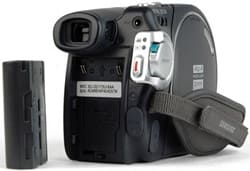
Battery Life*** (10.9)*
We tested the life of the SC-DC173’s SB-LSM80 battery pack by setting the camcorder to auto, disabling DIS, and recording continuously in the highest quality with the LCD flipped out. When a disc needed to be changed, the external power was immediately plugged in and the battery pack was removed while the DVD-RW disc was reformatted. The SC-DC173’s battery lasted a total of 67 minutes (1 hour and 7 minutes), which is a truly weak performance.
Audio / Playback / Connectivity
Audio* (3.0)*
If you’ve taken notice of our scrutiny regarding the SC-DC173’s poor entry-level offerings throughout this review, get ready for more. The SC-DC173’s front-mounted stereo microphone features a wind cut function, and that’s it. This is all the audio control you have over the SC-DC173. No mic jack like last year’s SC-DC164. No headphone jack. No level controls. No hot shoe. Nothing. This is about as point-and-shoot as you can get.
Playback* (3.0)*
Playing back footage on the SC-DC173 is not rocket science, but you’ll have to take a few steps before you can enjoy your treasured moments. To play back video clips, make sure the disc/card switch is set to "disc." Then, shift up once on the large mode dial. A screen with up to six icons at a time will appear, representing individual video clips. You can scroll through the clips via the joystick and select a clip by pressing the center of the joystick. When a clip is selected, it begins playing within the entirety of the LCD screen or viewfinder. To pause a clip, press the center of the joystick, and to stop a clip and return to the main icon screen, shift down. Rewind and fast forward are controlled by the left and right positions on the joystick, and you can choose between two speeds. Audio is controlled via the zoom in/out buttons in the LCD panel. The joystick has very small labels indicating which direction is play, which is fast forward, and so on. It’s not easy to read, but miles beyond what JVC offers – no instructions.
While in video Playback mode, the Administrative menu can be accessed by pressing the menu button. This time, a list of four options appears—Memory, Disc Manager, Display, and System. Memory lets you set the photo quality. Disc Manager consists of disc finalize, disc un-finalize, disc format, and disc info settings. Display offers LCD bright, LCD color, date/time, and TV display settings. System is comprised of clock set, beep sound, and language settings.
To play back still images, slide the disc/card button to card. Shift up on the mode dial and a 4:3 aspect screen will appear, consisting of up to six icons representing still images. Two tabs appear at the top—photo and video. To view recorded still images, use the joystick to select and press its center to view an individual image. Use the left and right joystick controls to scroll through pictures, but beware—it takes up to five seconds to shift to the next image. At any point, you can press the multi display button, which will bring you back to the main icon screen. Here, the Administrative menu consists of three options—Memory, Display, and System. Memory is composed of delete, delete all, protect, print mark, and format settings. Display consists of LCD bright, LCD color, date/time, and TV display settings. System offers clock set, beep sound, USB connect, and language settings.
Connectivity* (4.0)*
Last year’s SC-DC164 featured an intelligent port design, characterized by a convenient vertical strip located in the LCD cavity. The camcorder even included a mic jack mounted to the back. This year, Samsung obliterated that solid idea and opted for randomness and carelessness. Ports on the SC-DC173 are strewn throughout the camcorder’s body in odd, hard-to-reach places. The USB terminal is located underneath the rear hand strap anchor, the DC input is tucked in back, and the SD/MMC card slot is slapped to the bottom of the camcorder. At least all of these ports are secured by rugged plastic enclosures. However, you may be wondering where the AV jack went. Well, it’s mounted to the top of the back next to the viewfinder, uncovered and naked to the world. This is pure silliness, Samsung. Was it that much of a budget threat to toss on just one more port cover?
Other Features
What’s in the Box?
The Samsung SC-DC173 ships with the following items:
-SB-LSM80 Battery Pack
-AA-E9 Type AC Adapter
-AV Cable
-Instruction Book/Quick Guide
-Lithium Batteries
-Remote Control
-USB Cable
-Software CD
-Lens Cover
-Lens Cover Strap
The manual states that depending on the sales region, the SC-DC173 will ship with a 3.5-inch DVD-RW disc and carrying case. Our model did not.
Other Features* (2.0)*
*Digital Effects - *The SC-DC173 offers the following digital effects: Art, Mosaic, Sepia, Negative, and Mirror (which can only be activated in 4:3 mode). Initializing the Sepia tone effect is interesting because it doesn’t make a huge noticeable difference from the regular Shooting mode (since the SC-DC173’s picture looks somewhat sepia toned already).
*C.Night/Video Light- *The SC-DC173 is equipped with a video light, but only when C.Night mode is activated. C.Night mode is accessed by pressing the C.Night/light button located within the LCD cavity. When pressed once, the shutter speed drops to 1/30, a second press drops it down to 1/15, and a third press engages the video light along with the 1/15 shutter. Why can the LED only be used in 1/15 shutter speed? The world may never know.
Comparisons / Conclusion
Comparison
Samsung SC-DC164
Samsung’s revamping of last year’s SC-DC164 ($499 MSRP) amounts to a perplexing tradeoff of good and bad features. The SC-DC164 is equipped with a 1/4.5-inch sensor and spouting a 680,000 gross pixel count. Larger pixels should lead to better low light, but the SC-DC164 spirals downward with a blurry mess of an image. Sadly, this year’s SC-DC173 produced a slightly worse image due to its 1/6-inch chip with 680,000 gross pixel count.
Video performance aside, let’s talks about some peculiar handling traits that were dropped or gained. The SC-DC164 featured a mic jack, extendable viewfinder, 800 x 600 max stills, and an organized column of ports located within the LCD cavity. The SC-DC173 offers a more organized LCD cavity, LCD panel controls, and a video light (though only in conjunction with C.Night mode). This is a pretty sorry offering as far as enhancements go. Yes, the SC-DC173 is cheaper, but is it worth any green? In this case, you’re stuck between worse and worst. Our advice? Don’t buy these Samsungs.
Sony DCR-DVD108
Sony’s DCR-DVD108 ($399 MSRP) is a $30 price leap, but it’s worth every penny. Though both camcorders are equipped with 1/6-inch chips with a 680,000 resolution, the DCR-DVD108 produces superior color balance and sharpness. Low light is weak, like any camcorder within this price range, but not much better or worse than the SC-DC173. The DCR-DVD108 also features an extendable viewfinder, touch screen LCD, and classic Easy button. It also touts a whopping 40x optical zoom, trumping the SC-DC173’s 34x optical. In this case, what it all comes down to is quality. Sony has produced a better entry-level DVD camcorder. Roll up an extra $30 in change and spring for the DCR-DVD108.
Canon DC220
The Canon DC220 ($449 MSRP) gave a good color performance in bright light with its 1/6", 680,000 CCD, but low light was heightened by abounding noise and blur. Still, the DC220’s video performance quelled that of the SC-DC173’s. So now it’s down to handling and manual controls. The DC220 features a handy rear-mounted joystick, which makes menu navigation a breeze. However, the DC220 does not include a distinct Easy mode and is strapped with an enclosed battery design, no video light, and a more complex menu. Point-and-shooters with more experience will opt for the DC220 because of its more advanced manual controls, in addition to a host of Program AE settings. Also, the DC220 has a maximum still capacity of 1024 x 768, accompanied by a histogram and other useful stills features. An $80 price gap is a bit of a stretch, but there’s no question here. It’s Canon all the way.
Hitachi DZ-GX5020A
Both the Hitachi DZ-GX5020A ($349 MSRP) and the SC-DC173 camcorders are saddled with a 1/6-inch imager with a 680,000 gross pixel count. Only Hitachi makes matters worse by going without a joystick, which is one notch down from the SC-DC173’s square, side-mounted joystick. The DZ-GX5020A does feature an extendable viewfinder, quick menu, and convenient finalize button, but that’s about it. Both camcorders are relatively comfortable to hold—that’s another plus. The bottom line is that neither of these entry-level contenders are adequate performers. Stick with a Sony or Panasonic.
Who It’s For
Point-and-Shooters
The SC-DC173 resonates "point-and-shooter" from miles away. Between the Easy.Q button, quick menu, and massive zoom, mom and dad will have a field day.
Budget Consumers
At $369, we’re not talking big dollars here, but in this case you get less bang than you should for your buck. The SC-DC173 under-delivers to the highest degree. Protect your piggy bank, budget consumers.
Still Photo / Video Camera Hybrid
The highest still resolution you get with the SC-DC173 is 640 x 480. You can record video and stills to an SD/MMC card, but the quality is just dreadful. We’re not seeing it here, either.
Gadget Freaks
Nothing about the SC-DC173 will pique the hyperactive interest of the gadget freak.
Manual Control Freaks
This may be the one category the SC-DC173 performs fairly well in. Between focus, shutter speed, white balance, and exposure, the SC-DC173 is well equipped for an entry-level point-and-shooter.
Pros / Serious Hobbyists
Hah!
Conclusion
The Samsung SC-DC173U (the "U" is for U.S. release) is a marginal effort, which is not surprising in entry-level camcorders. There’s so much compromise at this price point that it really requires the consumer to know what they want in order to pick the right brand. No one camcorder can do it all. Under $500, Sony dominates ease of use, with Canon a close second. Canon often has the best image quality, but not always. Panasonic packs in the manual controls. Thus it has been for years.
So where does that leave Samsung. The SC-DC173 is a potpourri of all three, excelling at none. The manual control suite is good, but the button and joystick placement is poor. The camcorder is easy to use, but in order to the best picture quality, the shooter needs to intercede, and the camcorder’s Easy Q mode is too restrictive to do so easily. We were pleased to see that the image quality was not too bad, at least not compared to other camcorders in its range. The image certainly lacked definition, but the color performance was better than expected. Handling is the biggest problem with the SC-DC173, which is not a simple fix for Samsung to correct in next year’s model. Putting nearly every control on the left side of the camcorder is a strategy that nearly every manufacturer has left behind over the last few years. To see the same error made again makes no sense.
The Samsung SC-DC173 is not for everyone, but the redeeming qualities make it one of the better offerings from a company outside the major DVD camcorder manufacturers, Sony, Canon, and Panasonic.
Photo Gallery
Meet the tester

Michael Perlman
Editor
Michael Perlman is a valued contributor to the Reviewed.com family of sites.
Checking our work.
Our team is here for one purpose: to help you buy the best stuff and love what you own. Our writers, editors, and lab technicians obsess over the products we cover to make sure you're confident and satisfied. Have a different opinion about something we recommend? Email us and we'll compare notes.
Shoot us an email